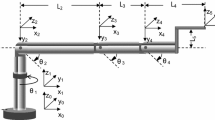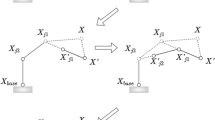Abstract
The neural-network-based inverse kinematics solution is one of the recent topics in the robotics because of the fact that many traditional inverse kinematics problem solutions such as geometric, iterative and algebraic are inadequate for redundant robots. However, since the neural networks work with an acceptable error, the error at the end of inverse kinematics learning should be minimized. In this study, simulated annealing (SA) algorithm was used together with the neural-network-based inverse kinematics problem solution robots to minimize the error at the end effector. The solution method is applied to Stanford and Puma 560 six-joint robot models to show the efficiency. The proposed algorithm combines the characteristics of neural network and an optimization technique to obtain the best solution for the critical robotic applications. Three Elman neural networks were trained using separate training sets and different parameters, since one of them can give better results than the others can. The best result is selected within three neural network results by computing the end effector error via direct kinematics equation of the robotic manipulator. The decimal part of the neural network result was improved up to 10 digits using simulated annealing algorithm. The obtained best solution is given to the simulated annealing algorithm to find the best-fitting 10 digits for the decimal part of the solution. The end effector error was reduced significantly.






Similar content being viewed by others
References
Bingul Z, Ertunc HM, Oysu C (2005) Comparison of inverse kinematics solutions using neural network for 6R robot manipulator with offset. In: Proceedings of the IEEE international conference on computational intelligence and applications, Istanbul, Turkey, pp 1–5
Çakar T, Yazgan HR, Köker R (2008) Parallel robot manipulators, new developments. In: Ryu J-H (ed) Parallel robot scheduling with genetic algorithms. I-Tech Education and Publishing, Vienna, pp 153–170
Çakar T, Köker R, Demir I (2008) Parallel robot scheduling to minimize mean tardiness with precedence constraints using a genetic algorithm. Adv Eng Softw 39(1):47–54
Cheng YC, Qi WM, Chai WY (2002) Dynamic properties of Elman and modified Elman neural network. In: Proceedings of the 1st international conference on machine learning and cybernetics, Beijing, pp 637–640
Daunicht W (1991) Approximation of the inverse kinematics of an industrial robot by DEFAnet. Proc IEEE Int Jt Conf Neural Netw Singap 3:1995–2000
Fu KS, Gonzalez RC, Lee CSG (1987) Robotics: control, sensing, vision and intelligence. Mcgraw-Hill, USA, p 38
Garg DP, Kumar M (2002) Optimization techniques applied to multiple manipulators for path planning and torques minimization. Eng Appl Artif Intell 15:241–252
Hasan MT, Demuth HB, Beale MH (1996) Neural networks design. PWS Publishing, Boston
Hasan MT, Menhaj M (1994) Training feed forward networks with the Marquardt algorithm. IEEE Trans Neural Netw 5(6):989–993
Haykin S (2009) Neural networks and learning machines, 3rd edn. Pearson International Edition, New Jersey
Horacio MA, Simon GG (1998) Mobile robot path planning and tracking using simulated annealing and fuzzy logic control. Expert Syst Appl 15:421–429
Karkoub M, Elkamel A (1997) Modelling pressure distribution in a rectangular gas bearing using neural networks. Tribol Int 30(2):139–150
Kalra P, Mahapatra PB, Aggarwal DK (2006) An evolutionary approach for solving the multimodal inverse kinematics problem of industrial robots. Mech Mach Theory 41:1213–1229
Karlik B, Aydin S (2000) An improved approach to the solution of inverse kinematics problems for robot manipulators. Eng Appl Artif Intell 13:159–164
Kim DW, Kim KH, Jang W, Chen FF (2002) Unrelated parallel machine scheduling with setup times using simulated annealing. Robotics Comput Integr Manuf 18:223–231
Kozakiewicz K, Ogiso T, Miyake N (1991) Partitioned neural network architecture for inverse kinematics calculation of a 6 DOF robot manipulator. Proc IEEE Int Jt Conf Neural Netw Singap 5:2001–2006
Köker R, Oz C, Cakar T, Ekiz H (2004) A study of neural network based inverse kinematics solution for a three-joint robot. Robotics Auton Syst 49:227–234
Köker R (2005) Reliability-based approach to the inverse kinematics solution of robots using the Elman’s network. Eng Appl Artif Intell 18:685–693
Koker R (2006) Design and performance of an intelligent predictive controller for a six-degree-of-freedom robot using the Elman network. Inf Sci 176:1781–1799
Kuroe Y, Nakai Y, Mori T (1993) A new neural network approach to the inverse kinematics problem in robotics. In: IEEE motion control proceeding, pp 112–117
Küçük S, Bingül Z (2004) The inverse kinematics solutions of industrial robot manipulators. In: Proceedings of the IEEE international conference on mechatronics, Kuşadası, Turkey, pp 274–279
Küçük S, Bingül Z (2005) The inverse kinematics solutions of fundamental robot manipulators with offset wrist. In: Proceedings of the IEEE international conference on mechatronics, Taipei, Taiwan, pp 197–202
Mooring BW, Roth ZS, Driels MR (1991) Fundamentals of manipulator calibration. Wiley, USA
Morris AS, Khemaissa S (1995) Stable fast neurocontroller for robot arm movement. IEE Proc Control Theory Appl 142(4):378–384
Nearchou AC (1998) Solving the inverse kinematics problem of redundant robots operating in complex environment via a modified genetic algorithm. Mech Mach Theory 33(3):273–292
Oysu C, Bingul Z (2009) Application of heuristic and hybrid-GASA algorithms to tool-path optimization problem for minimizing airtime during machining. Eng Appl Artif Intell 22:389–396
Safak KK, Turkay OS (2000) Experimental identification of universal motor dynamics using neural networks. Mechatronics 10:881
Saramago SFP, Steffen JV (2001) Trajectory modelling of robot manipulators in the presence of obstacles. J Optim Theory Appl 110(1):17–34
Tabendeh S, Clark C, Melek W (2006) A genetic algorithm approach to solve for multiple solutions of inverse kinematics using adaptive niching and clustering. In: IEEE Congress on Evolutionary Computation, July 16–21, Canada, pp 1815–1822
Author information
Authors and Affiliations
Corresponding author
Rights and permissions
About this article
Cite this article
Köker, R. A neuro-simulated annealing approach to the inverse kinematics solution of redundant robotic manipulators. Engineering with Computers 29, 507–515 (2013). https://doi.org/10.1007/s00366-012-0277-7
Received:
Accepted:
Published:
Issue Date:
DOI: https://doi.org/10.1007/s00366-012-0277-7




